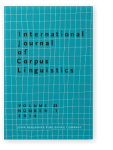Vol. 23:1 (2018) ► pp.55–84
Lexical preference and variation in the complementation of provide
A parser- and data-driven approach
This paper investigates grammatical variation in the complementation of the verb provide. It describes the distribution of the four possible patterns with two internal arguments and the interaction between pattern choice and lexical choice. The study finds and documents significant differences in the preferred complementation patterns for American and British English as well as for spoken and written news genres. It also establishes the double object construction as a viable option for American English. Methodologically, this study is based on robust automatic syntactic annotation and computerized retrieval from a data-set comprising 2.5 billion words. It is this large amount of data that permits the observation of strong preferences in terms of pattern choice at the interface between grammar and lexis.
Article outline
- 1.Introduction
- 2.Verb complementation and syntax-lexis interactions
- 3.Data and method
- 3.1Annotation
- 3.2Retrieval
- 3.3Manual annotation
- 4.Results: Variation and lexical preference
- 4.1Distribution of the complementation patterns
- 4.2Lexical preferences: Automatic analysis
- 4.3 Provide chance: Exploring a lexical type
- 5.Conclusion
-
References
